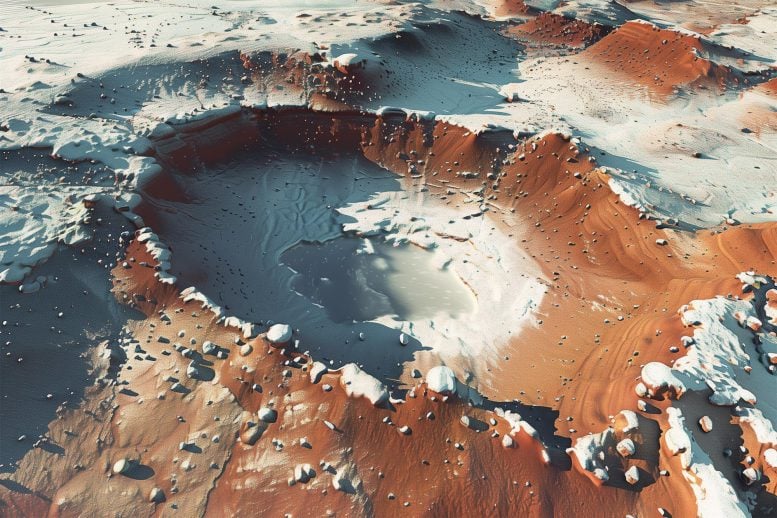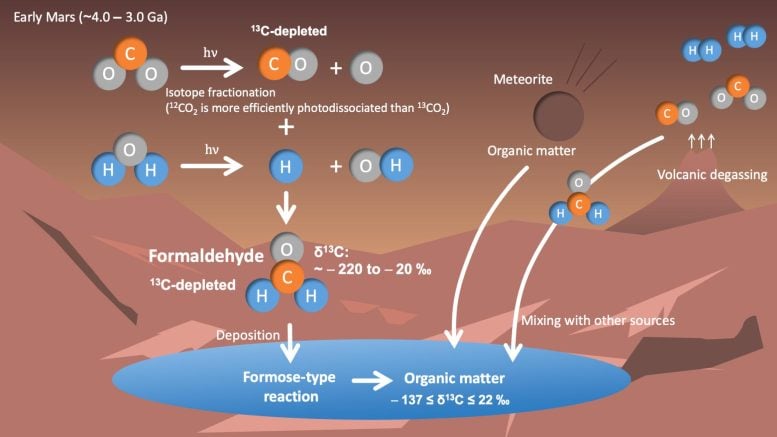

Research at Tohoku University has provided new insights into the ancient Martian environment, revealing that organic matter potentially indicative of past life could have been produced from formaldehyde.
Using a novel model combining atmospheric and photochemical analyses, the team discovered variations in the carbon isotope ratios in Martian sediments, suggesting that conditions billions of years ago might have supported the creation of life-essential molecules like sugars and ribose.
Discovering Ancient Water and Life’s Potential on Mars
Currently, Mars is a cold, dry planet. However, geological evidence suggests that liquid water existed there around 3 to 4 billion years ago. Where there is water, there is usually life. In their quest to answer the burning question about life on Mars, scientists at Tohoku University developed a detailed model of organic matter production in the ancient Martian atmosphere.
Organic matter refers to the remains of living things such as plants and animals, or the byproduct of certain chemical reactions. Whatever the case, the stable carbon isotope ratio (13C/12C) found in organic matter provides valuable clues about how these building blocks of life were originally formed, giving scientists a window into the past.
As such, it has become a point of interest for Mars expeditions. For example, the Mars rover Curiosity (operated by NASA) revealed that organic matter found in sediments from that era on Mars was unusually depleted in 13C. It was also discovered that the carbon isotope ratios varied significantly between samples. However, the reason for this variability was a mystery.

Modeling Organic Compounds in Martian Atmosphere
To expand on these findings, a research group led by Shungo Koyama, Tatsuya Yoshida, and Naoki Terada from Tohoku University developed a Martian atmospheric evolution model. The model focused on formaldehyde (H2CO), which members of this research team previously determined could feasibly be produced in the ancient Martian atmosphere.
The reason for this choice is that formaldehyde can generate complex organic compounds such as sugars, which are essential for life. In other words, formaldehyde may be the missing factor that could explain the anomalous values of the Curiosity rover samples. It could also be a sign of past life.
Formaldehyde and the Origins of Martian Organic Matter
This model combined a photochemical model with a climate model to estimate the changes in the carbon isotope ratio of formaldehyde on Mars, dating back 3 to 4 billion years. It revealed that the depletion of 13C in formaldehyde is due to the photodissociation of CO2 by solar ultraviolet radiation, which results in the preference of one stable isotope over another.
The study also showed that the carbon isotope ratio varied based on factors such as the atmospheric pressure on Mars at the time, the fraction of light reflected by the planet’s surface, the ratio of CO to CO2, and the amount of hydrogen released by volcanic activity.
Implications for Mars’ Ancient Biochemistry
“This model provides a possible explanation for previously unexplained findings, such as why 13C was mysteriously depleted,” remarks Koyama, a graduate student at Tohoku University.
This discovery indicates that formaldehyde contributed to the formation of organic matter on ancient Mars, implying that bio-important molecules such as sugars and ribose (a component of RNA, which is present in all living cells) may have been produced on the planet.
These findings were published on September 17, 2024, in the journal Scientific Reports.
Reference: “Stable carbon isotope evolution of formaldehyde on early Mars” by Shungo Koyama, Tatsuya Yoshida, Yoshihiro Furukawa, Naoki Terada, Yuichiro Ueno, Yuki Nakamura, Arihiro Kamada, Takeshi Kuroda and Ann Carine Vandaele, 17 September 2024, Scientific Reports.
DOI: 10.1038/s41598-024-71301-w